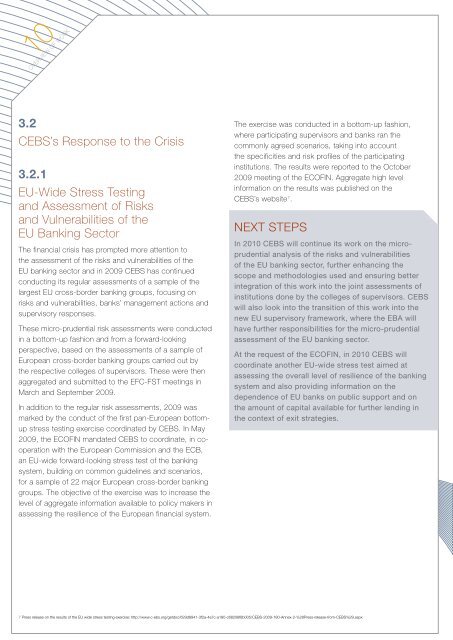Annual Report 2009 - European Banking Authority - Europa
Annual Report 2009 - European Banking Authority - Europa
Annual Report 2009 - European Banking Authority - Europa
You also want an ePaper? Increase the reach of your titles
YUMPU automatically turns print PDFs into web optimized ePapers that Google loves.
10<br />
OVERVIEW OF WORK<br />
11<br />
OVERVIEW OF WORK<br />
3.2<br />
CEBS’s Response to the Crisis<br />
3.2.1<br />
EU-Wide Stress Testing<br />
and Assessment of Risks<br />
and Vulnerabilities of the<br />
EU <strong>Banking</strong> Sector<br />
The financial crisis has prompted more attention to<br />
the assessment of the risks and vulnerabilities of the<br />
EU banking sector and in <strong>2009</strong> CEBS has continued<br />
conducting its regular assessments of a sample of the<br />
largest EU cross-border banking groups, focusing on<br />
risks and vulnerabilities, banks’ management actions and<br />
supervisory responses.<br />
These micro-prudential risk assessments were conducted<br />
in a bottom-up fashion and from a forward-looking<br />
perspective, based on the assessments of a sample of<br />
<strong>European</strong> cross-border banking groups carried out by<br />
the respective colleges of supervisors. These were then<br />
aggregated and submitted to the EFC-FST meetings in<br />
March and September <strong>2009</strong>.<br />
In addition to the regular risk assessments, <strong>2009</strong> was<br />
marked by the conduct of the first pan-<strong>European</strong> bottomup<br />
stress testing exercise coordinated by CEBS. In May<br />
<strong>2009</strong>, the ECOFIN mandated CEBS to coordinate, in cooperation<br />
with the <strong>European</strong> Commission and the ECB,<br />
an EU-wide forward-looking stress test of the banking<br />
system, building on common guidelines and scenarios,<br />
for a sample of 22 major <strong>European</strong> cross-border banking<br />
groups. The objective of the exercise was to increase the<br />
level of aggregate information available to policy makers in<br />
assessing the resilience of the <strong>European</strong> financial system.<br />
The exercise was conducted in a bottom-up fashion,<br />
where participating supervisors and banks ran the<br />
commonly agreed scenarios, taking into account<br />
the specificities and risk profiles of the participating<br />
institutions. The results were reported to the October<br />
<strong>2009</strong> meeting of the ECOFIN. Aggregate high level<br />
information on the results was published on the<br />
CEBS’s website 7 .<br />
NEXT STEPS<br />
In 2010 CEBS will continue its work on the microprudential<br />
analysis of the risks and vulnerabilities<br />
of the EU banking sector, further enhancing the<br />
scope and methodologies used and ensuring better<br />
integration of this work into the joint assessments of<br />
institutions done by the colleges of supervisors. CEBS<br />
will also look into the transition of this work into the<br />
new EU supervisory framework, where the EBA will<br />
have further responsibilities for the micro-prudential<br />
assessment of the EU banking sector.<br />
At the request of the ECOFIN, in 2010 CEBS will<br />
coordinate another EU-wide stress test aimed at<br />
assessing the overall level of resilience of the banking<br />
system and also providing information on the<br />
dependence of EU banks on public support and on<br />
the amount of capital available for further lending in<br />
the context of exit strategies.<br />
7 Press release on the results of the EU wide stress testing exercise: http://www.c-ebs.org/getdoc/629d8941-3f2a-4a7c-a180-c68208f8b005/CEBS-<strong>2009</strong>-180-Annex-2-%28Press-release-from-CEBS%29.aspx

















